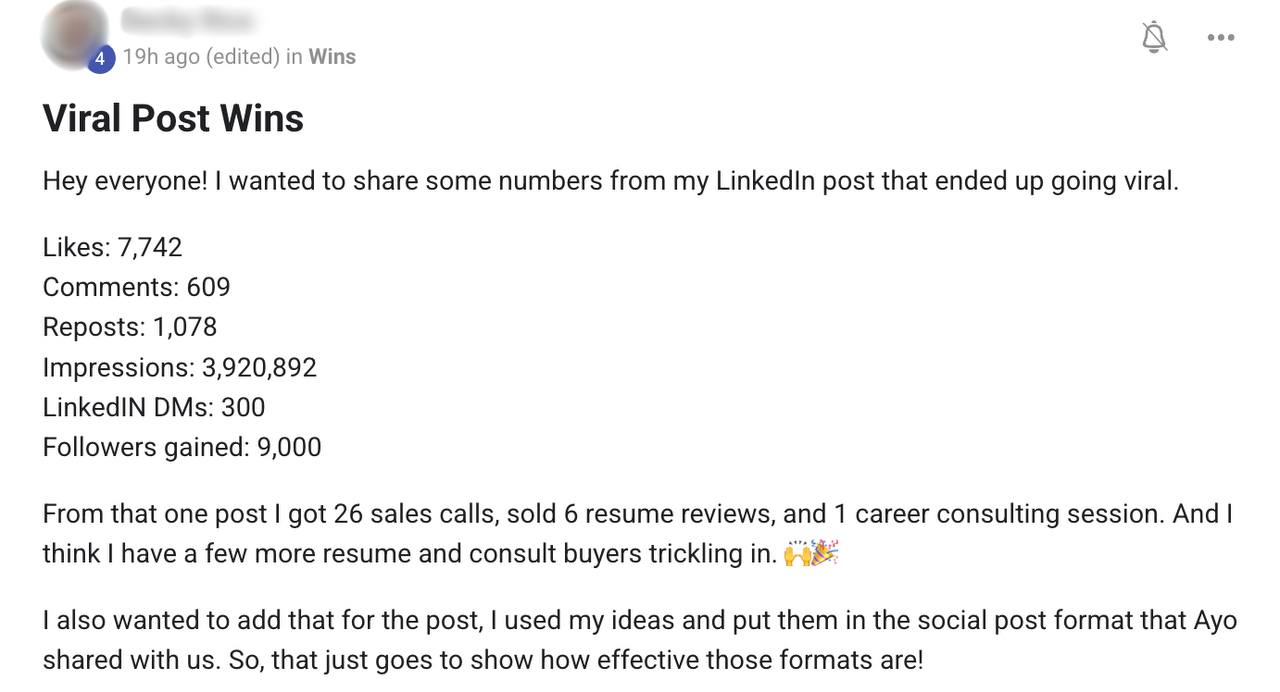
The two letters that spark fear in the hearts of some and dollar signs in the eyes of others:
AI
Like it or not, AI is here to stay. If you are wise, you’ll use it to accelerate your career. If you don’t, you’ll get left behind.
I made $500,000 in 2025. I plan to hit $1 million this year. Here are my best tips for how to use AI in business.
1. Make deals and close sales with AI assistance
For context, it might be helpful to have some background on the type of small business I run and how I get customers.
I coach skilled professionals to land clients using content marketing.
Here is the process I use to get clients:
- I create content on social media targeting my ideal clients’ pain points and desires
- I send direct messages to people who engage with my content to discuss problems and pitch the idea of working together
- If it makes sense for both of us, we’ll hop on a sales call to (hopefully) close the deal
The process works well, but a problem started to arise.
A lot of my prospects were treating the sales calls like sessions to understand what I sell, instead of treating them like calls to make a decision right then and there.
Jeremy is a marketer in the online education space who helps his clients hit $1 million per month and has done so with 40+ clients. Since I wanted to go big with my business, I decided it was time to follow big players.
I watched this video about this exact problem: prospects showing up to the call uneducated, which leads to them saying, “I’ll think about it.”
A lot of business owners and sales closers blame the prospects and call them “tire kickers,” treating them like low-quality leads. In reality, they rightfully need more information to decide to spend thousands of dollars with someone they just met. Go figure.
Jeremy’s solution? The “hammer them” strategy. Here’s how it works:
Someone books a sales call. In between the time they book the sales call and the time they show up, they get 15 emails sent directly to them and see 30-50 pieces of short-form video content in the form of Instagram ads, specifically for that custom segment of people. (Now you see why it’s called the “hammer them” strategy.)
The point of the emails and the videos? Pre-handle all of the objections and mentally prepare the prospect to make a buying decision.
I’ll admit I was a tiny bit skeptical.
I wondered if people would get annoyed if I sent them that much communication. But I figured I’d listen to the guy who makes 20 times more money than I do instead of trusting my own judgement.
From data dump to killer content
This is where AI comes in.
I downloaded the transcript of the video using an AI YouTube text-to-transcription tool.
After that, I uploaded it to Claude to give me the bullet points of the hammer strategy and specific guidance on how to execute it. The report told me to gather all the common FAQs, objections, and things people need to know before they buy.
Instead of manually searching for these insights, I used AI.
Otter AI automatically transcribes every Zoom call I take. So I uploaded the transcripts of all of my sales calls onto a “project,” which just means a place where you can store lots of data. Then, you can continually draw from your project, instead of having to create a new chat for every request. I treat these projects like “second brains.”
I asked Claude:
Give me the top 10 FAQs, objections, and things people need to know before they buy the offer based on the transcripts of sales calls. Also, pull out 20 word-for-word verbatim phrases from prospects on calls so I can insert them directly into copy for an email sequence to educate them before they buy.
Voila. I had all the information needed for the hammer them strategy. When it came to writing the emails themselves? I also used AI. I still write my main pieces of content like posts, social media, and emails to my list, but for tasks like this, I will use AI assistance to make the process faster.
I took all of the FAQs, objections, and concerns and cross-referenced them with a prompt telling Claude to generate 15 emails for the hammer sequence.
(Claude knew what the hammer sequence was because the notes were already in the project.)
It spat out 15 pretty damn good emails, I lightly edited them, and set them up to run on auto-pilot.
I closed my next sales call with essentially zero objections. Jeremy was right, and AI helped me prove his thesis fast.
2. Free up time for what matters most
When you run a business, you have to deal with trade-offs and opportunity costs when it comes to how you spend your time.
Your top priorities are always:
- Marketing, lead generation, and generating sales
- Client fulfillment and service delivery
When you turn the dial up on one, the other tends to suffer.
You want to help your clients and customers get great results, but if you spend so much time delivering that you turn off the marketing machine, the well can run dry quickly.
If you spend too much time on marketing and sales and ignore product quality and service delivery, that’s no good either. Your clients will churn, your lifetime value per customer (LTV) decreases, and you run the risk of ruining your reputation.
This is a tough nut to track.
So what do you do?
Use AI to make service delivery easier (without sacrificing quality)
This is where the Words to Dollars second brain comes in.
It’s a project I host on Claude that contains:
- Documents from every training I’ve created
- Transcripts from calls I’ve had with clients
- Examples of my own sales and marketing materials
I did the heavy lifting up front, spending months creating high-quality content that helps clients get results, so now AI can help with specific aspects of fulfillment.
For example, if a client comes to the community portal with a specific question, I can plug it into my second brain and create a detailed answer that’s based on my philosophy (even though it wasn’t written by me).
I can give detailed feedback on sales and marketing materials for my clients with a click of a button.
I’m able to generate complete offer documents and sales pages for them to use as a foundation.
For my private one-on-one clients, whom I work to grow their businesses to $30K per month in 12 months, I created second brains for every one of them. This allows me to provide insights to help them grow.
One of my clients was struggling with the performance of his content, so I created a comparison analysis with him and one of his competitors—whose content was more in line with what I felt he should be making—and shared it with him so he could improve his content.
I had my virtual assistant compile a bunch of LinkedIn posts from said competitor, as well as my clients, and added them to the project. It already contained background details on his offer, target audience, and recordings from his sales calls. I was able to generate a 2,000-word report that my client used to improve his content immediately.
If you’re clever about it, AI tools can cut down the time on your service delivery quite a bit. This gives you more time to spend on marketing, which helps you grow your business without sacrificing product quality.
3. Build your own AI life coach and business advisor
When you run a business, the biggest bottleneck or constraint to your business is…you. Your business only grows in proportion to how much you grow.
There are many different factors involved in not just the day-to-day of your business, but your personal life that can affect how much money you make, like:
- Diet and exercise
- How you manage stress
- How you make decisions, and how fast you make decisions
- The quality and health of your relationships
- How you allocate time, money, energy, and resources to grow your business.
I use AI as my advisor in both capacities to help myself grow and my business grow.
Let’s start with a practical business example:
I keep metrics on specific numbers to guide my business decisions:
- Calls booked per month
- Show rate: the percentage of people who show up for the sales call
- Close rate: the percentage of people who close on the call
- Average order value: how much money they spend directly on the call
- Customer lifetime value: how much money the customer spends in the entire life cycle of being a customer
Recently, I wanted to know if I should raise the price of my program from $5,000 to $6,000. A lot of people say that if your offer starts to close above 40%, it’s time to raise your price. But I wanted to be sure. I went to Claude and asked him to model out the numbers for me:
- Would I make more net cash with a higher price but a lower close rate?
- How would the average order value look if the ratio stayed constant?
- How should I experiment at the new price point to test it before implementing it fully?
Claude gave me all of the answers I needed. Turns out it made sense to raise the price, and my small business is more profitable as a result.
Let’s look at an example of how I manage myself:
I felt like I wasn’t spending my time efficiently, so I decided to do a time audit. For two weeks, I measure out every single activity in my day in 15-minute increments and categorize them into different labels:
- Sales calls
- Lead generation
- Content creation
- Personal time
- Business strategy (marketing external)
- Business strategy (product internal)
I really wanted to see where my time was going.
After I did this for two weeks, I uploaded the information to Claude along with the goals and objectives I had for my business in Q2. It suggested a new routine and time management process based on real data that I could use to change my routine so I could make more money.
For more reading on growth and goals, check out these posts:
4. Use AI to drive the continuous cycle of results to cash
The success of your clients helps you make more money because they are the proof that the your product works. And when you have that proof, more people want to buy it.
Not only am I using AI to aid in service delivery on my end, but I am also doing it to help my clients make the process easier on their end, so they can get results faster for their small businesses.
This makes them more satisfied with the product, which means referrals, testimonials, and case studies I can use to get more clients.
There are multiple skills I teach my clients to help them make money, like market research, idea generation, building offers, lead generation and outreach, content posting frameworks, sales techniques—you name it.
My clients are usually good at what they do, but need help with the activities that bring clients in the door.
Let’s take content, for example.
I have a content ideation exercise called the four-factor analysis where you list out the fears, frustrations, hopes, and aspirations of your target audience. Doing this helps you come up with content ideas based on things your potential clients care about.
It’s a powerful exercise, but it takes a lot of time. Some people just aren’t good at doing it, period. I’ve seen past students take months to complete it.
With AI, they can generate the output in 30 seconds.
I also put together a framework that helps them turn those ideas into pieces of content. I created a “swipe file” filled with a bunch of examples of posts from popular creators on different social media platforms.
Well-done social media content has a specific pattern and style that works—clever hooks, crisp, punchy writing, aesthetically pleasing line spacing.
This style doesn’t come naturally to a lot of people, especially some of my clients who only use writing and content as a means to an end for acquiring new clients.
I put together a set of prompts for them that helps them create AI-generated content based on the style of popular creators, rooted in the foundation of client-focused market research.
It works.
One my my clients used it to get 4 million impressions on her LinkedIn post on her third ever piece of social media content. Let that sink in.
A flood of leads hit her inbox, which led to her reaching $10,000 per month in her business in less than 60 days after we started. A complete beginner built a business with a six-figure run rate thanks to the help of AI.
I am creating more and more resources to leverage AI to make the lives of my clients easier.
It just makes sense. Which leads to the most important way I’m using AI to grow my business in 2025…
5. Make AI an integral part of your small business (or get left behind)
I mentioned this quote in my post about Cal Newport and his ideas for how to get ahead in your career in the modern era:
In this new economy, three groups will have a particular advantage: those who can work well and creatively with intelligent machines, those who are the best at what they do, and those with access to capital.
We are living in fascinating times. AI is commodifying the rote application of skills—writing, coding, design, etc.
But what AI can’t do, at least not yet, is do the sort of imaginative strategy and innovation a human being can do…for now.
Many folks haven’t taken the commodification well.
I see a lot of posts on social media bashing AI-generated content.
But the truth is, when prompted well, AI does produce results.
I see designers upset that AI can spit out pretty interfaces. I’ve heard stories of entire software development teams being laid off. It’s tough out there.
A lot of people have their identities wrapped up in their skill set, so seeing AI get results like this puts them into a state of cognitive dissonance and denial.
Anybody who doesn’t think AI is coming for us all, eventually, just has their head buried in the sand.
Here’s how I see AI playing out in the short to intermediate term:
Strategy is going to be the new skill to have in 2025 and beyond.
The middle is dead. You can’t just know how to design an interface, or code, or write some copy. AI can already do all of those things.
But it takes a human being to understand the business problems that you can use AI to solve, or to simply be clever and motivated enough to use AI to figure it out.
AI is only as powerful as the person behind the machine.
Some people use simple and basic prompts and then proceed to say AI-generated output is garbage.
Meanwhile, others are launching custom-built apps from scratch without even knowing how to code.
Because they have ideas.
They have problems that the market wants solved.
And they are creative enough to think about the right solutions.
Moving forward, the rewards will go to a handful of AI-augmented super producers, and there will be lots of people struggling to find work and make a good living. It is what it is.
AI is here to stay, and it’s criminally foolish to ignore it.













